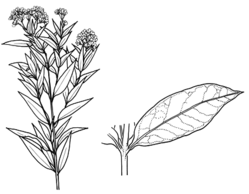Common name: Yellow Loosestrife
Lysimachia vulgaris var. davurica (Ledeb.) R.Knuth APNI* Synonyms: Lysimachia davurica Ledeb. APNI*
Lysimachia salicifolia F.Muell. ex Benth., nom. illeg. APNI*
Lysimachia muelleri N.P.Balakr. APNI*

Description: Rhizomatous herb; aerial stems erect, simple or weakly branched, to 1.5 (-2) m high, with mostly minute, erect, reddish brown-tipped glandular hairs, becoming glabrous on lower stem. Aerial stems die back after flowering and fruiting.
Leaves mostly opposite or in whorls of 3 or 4, elliptic to narrow-elliptic, lanceolate or oblanceolate, mostly 4–9 cm long and 10–22 (-32) mm wide (leaves becoming smaller towards stem apex), discolorous, green, paler beneath, minutley glandular-hairy, dotted with orange to blackish glands (glandular punctate), sessile or with petiole to 3 mm long.
Panicles terminal and upper-axillary, many-flowered. Flowers 9–15 mm diam.; pedicel mostly 5–12 mm long, with a distinctly shorter basal bract 2–6 mm long; sepals 3–4 mm long, lanceolate-ovate with an acuminate apex and distinct orange to blackish (on drying) glandular line on the outer surface near the margins, ciliolate with gland-tipped hairs; petals clearly exceeding the sepals, 6–9 mm long, bright yellow, often with minute orange to reddish glandular lines or dots; filaments with minute glandular hairs.
Capsule globose or subglobose, 2–4 mm diam., longer than persistent calyx when mature, with minute gland-tipped hairs at apex, longitudinally splitting from apex by usually 5 valves, many-seeded.
Flowering: December – March.
Distribution and occurrence: rare in Australia; recorded in several wetlands, including Wingecarribee Swamp (between Robertson and Moss Vale), a swamp/pond system in the Lower Boro - Braidwood area, and a lagoon near Bega. It has been found (but possibly no longer occurs) on the Northern Tablelands in a New England Tablelands (Bioregion) fen SW of Walcha and also known from a single 1898 collection from Timbarra E of Tenterfield (J.T. Hunter & D. Bell, Cunninghamia 11: 49-64, 2009). The Australian populations are far disjunct from the main natural range of this taxon in NE Asia where it occurs from Japan W to Mongolia and eastern Russia. Its occurrence in Australia may provide evidence supporting long-distance dispersal; in this case the agency is likely to have been migratory waterbirds, such as Latham's (Japanese) Snipe, which visit Australian wetlands in the summer. Habitat: grows in moist situations, including peatland swamps, stream banks and lagoons. Grows in damp soils to saturated peat, in sedgeland and wet heath communities, associated with Phragmites australis, Carex spp., Juncus spp., Bolboschoenus fluviatilis, Lycopus australis, Lythrum salicaria, Leptospermum spp. and Melaleuca ericifolia. Occurs in the listed ecological community 'Temperate Highland Peat Swamps on Sandstone'.
NSW subdivisions: SC, ?NT, CT, ST
Other Australian states: Vic.
Threatened species: NSW BCA: Endangered
Formerly in Myrsinaceae.
Text by P.G. Kodela (April 2006; last updated July 2012).
Taxon concept: Flora of NSW Vol. 1 (1990); revised in P.G. Kodela, Telopea 11(2): 147–154 (2006).
| The single variety in NSW. |
APNI* Provides a link to the Australian Plant Name Index (hosted by the Australian National Botanic Gardens) for comprehensive bibliographic data
***The AVH map option provides a detailed interactive Australia wide distribution map drawn from collections held by all major Australian herbaria participating in the Australian Virtual Herbarium project.
|


